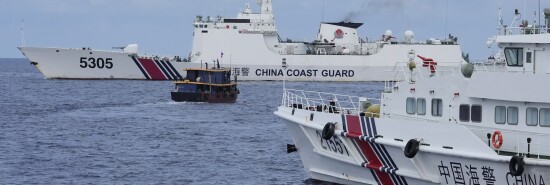
The US should reflag islands in the South China Sea
Michael Rubin
Video Embed
In 1987, President Ronald Reagan ordered the reflagging of nearly a dozen Kuwaiti tankers. Iran had begun attacking Kuwait’s tankers to restrict shipping in international waters and to coerce the emirate to cease its trade with and loans to Iraq. Reagan ignored criticism that reflagging the tankers could embroil the United States in war because he understood at stake were not only Kuwait’s oil exports but also freedom of navigation and the rules-based order. True, skirmishes did occur, but once the ayatollahs understood Reagan stood firm, Iranian forces suspended their provocations.
As China challenges freedom of navigation and the broader liberal order, perhaps the U.S. could take a page from Reagan’s playbook and reflag not ships but rather some of the rocks, reefs, and atolls over which China now erroneously claims sovereignty.
DESANTIS SHOWCASES ABILITY TO GOVERN WITH HURRICANE RESPONSE
The root of China’s claims is the “nine-dash line,” a creation based on a 1947 map whose authenticity historians dismiss. Chinese maps before the mid-20th century made no mention of the claim that Chinese diplomats today say is centuries old. That Beijing bases its claims on supposed historic Chinese fishing activity further displays the emptiness of the Chinese Communist Party’s logic: After all, Vietnamese, Taiwanese, Malay, Filipino, and Indonesian fishermen also plied the same waters and perhaps even some closer to China. Regardless, using the fictional map, China, in one fell swoop, claimed the bulk of the South China Sea and its considerable fishing and oil reserves. In 2016, the international Permanent Court of Arbitration in the Hague ruled China’s claims baseless.
Beijing does not care. It has been almost 20 years since the People’s Liberation Army began landing on various South China Sea rocks and reefs and claiming them exclusively for China. Not only did China deny access to their rightful owners, but in many cases, the country also began converting them into artificial islands, upon which it then built airfields, naval bases, and radar stations and installed missile batteries. It was archetypal salami-slicing, always advancing China’s military position but never going so far as to provoke outright war. In just the last month, the Chinese military has sought to interfere with the Philippines’s resupply of its marines in a South China Sea outpost.
It is against this backdrop that the U.S. might consider “reflagging” reefs and atolls in the region. These would not be land grabs but rather leases drawn between the U.S. government and its regional partners.
While the current U.S. legal position supports the 2016 Hague tribunal judgment that finds no power can legally exercise sovereignty over disputed territories, the White House might reconsider this for two reasons: First, not every maritime dispute is legitimate. Consider, for example, the Scarborough Shoal and Mischief Reef. The U.S. took possession of both along with the Philippines in the 1898 Treaty of Paris that ended the Spanish-American War. When the U.S. granted the Philippines independence in 1946, the U.S. transferred both maritime features to the Philippines. Beijing’s claim to either has about as much merit as would Bulgaria’s. Second, there is a limit to the wisdom of claiming legal victories if China is allowed to continue slicing the salami, encroaching on regional states every few years.
CLICK HERE TO READ MORE FROM THE WASHINGTON EXAMINER
A greater problem might be the unwillingness of regional states to offer leases. The Philippines, let alone Vietnam, can be prickly. Still, China’s aggression makes strange bedfellows and causes governments to reconsider the enmities of the past. Certainly, as my colleague Mike Mazza argues, the U.S. might provide armed convoys for the Philippines’s resupply missions to Second Thomas Shoal or deploy U.S. Marines alongside their Filipino colleagues on Thitu Island.
Temporary leases, meanwhile, can be a useful mechanism to funnel American assistance to defense ministries in Manila, Hanoi, or Jakarta. At the very least, a temporary lease would give the U.S. a seat at the table in negotiations, raise the stakes for Chinese aggression, and symbolically demonstrate international rejection of Chinese sovereignty even over those islands China already occupies.
Michael Rubin (@mrubin1971) is a contributor to the Washington Examiner’s Beltway Confidential blog. He is a senior fellow at the American Enterprise Institute.
